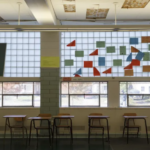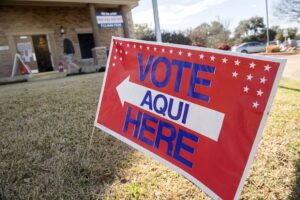After years of championing an “independent” commission to control the crucial redrawing of congressional and legislative districts, Democratic state leaders are taking over the process.
A wide coalition of advocates is demanding public hearings before Albany acts.
Assembly Speaker Carl Heastie (D-The Bronx) and Senate Majority Leader Andrea Stewart-Cousins (D-Westchester) said Wednesday that the state lawmakers will vote next week on new lines to be submitted by the Legislative Task Force on Demographic Research and Reapportionment (LATFOR), a small group of six politicians and political appointees where Democrats have control.
The move comes after the so-called Independent Redistricting Commission failed to produce new political maps ahead of a constitutional deadline, instead releasing dueling sets of district lines from its Democrat and GOP members .
Even before the Albany leaders’ announcement, some 60 community political and voter-rights organizations endorsed a letter sent Tuesday to the task force members stating that it “is imperative that LATFOR must hold at least one public hearing AFTER it has drawn its maps.”
The redistricting process could have huge repercussions for politics in New York and nationally. The new lines will be in place for a decade and New York is one of the few states where Democrats can craft favorable congressional district lines — key as they seek to bolster their five-seat majority in the U.S. House of Representatives.
A joint statement from Stewart-Cousins and Heastie stressed a need for speed.
“As per the New York State Constitution, it becomes the Legislature’s responsibility to consider fair maps that ensure all New Yorkers have equitable representation in their government,” they said. “That is a duty we take very seriously. Given the expedited nature of the political calendar, we fully expect the Senate and Assembly to consider new fair maps in a timely manner.”
Spokespeople for the Senate and Assembly majority didn’t answer a question from THE CITY asking whether they’d allow time prior to the vote for the public to respond to whatever maps the task force produces.
The process does need to move fairly quickly. Petitioning for June primaries will begin in March, and candidates need to know which areas they’ll be running to represent.
A Predictable Failure
Redistricting experts and advocates who spoke to THE CITY said that the move constituted a clear failure of the Legislature’s efforts to take the process out of lawmakers’ hands following the 2010 redistricting cycle. At the time, the GOP-controlled State Senate was accused of gerrymandering to maintain its majority, while a panel of judges stepped in to draw congressional district lines after the Senate and Democratic-led Assembly failed to reach agreement.
The Independent Redistricting Commission emerged in 2014 via an amendment to the state constitution. But some observers say that with its even partisan split, plus a back door option for the Legislature to take control of the process, the IRC was designed to fail.
“It was not set up in a very efficient manner and it was not intended to be an independent process. Despite the name of the commission being called the ‘Independent Redistricting Commission’ it was an advisory commission,” said Jeffrey Wice, a professor at New York Law School and a veteran advisor to the last four redistricting cycles in the state.
Signs flashed all along the way that the redistricting commission could fail.
In 2014, the nonprofit Common Cause New York successfully sued to have the word “independent” stripped from the amendment ballot proposal ultimately approved by New Yorkers, since the possibility that politicians could take the process over again was so blatant.
In September and December, the commission, which held dozens of public hearings in 2021, released two separate sets of partisan maps, blaming each other for the lack of cooperation.
“It was designed to fail,” said Susan Lerner, executive director for Common Cause, which was critical from the start of the commission plan and signed the letter demanding public hearings. “And it’s unfortunate that we were correct.”
Lerner suggested that the only way for New York to have a truly independent redistricting process is to put in place a body that is run by citizens instead of politicians or political appointees, such as the one California and Michigan have in place.
Wanting to Be Heard
Several groups are pushing to give feedback on the new lines and also want lawmakers to adopt a “unity map” that advocates crafted to keep minority groups together in districts where they can amass votes and political power.
“These are Latino, Black and Asian community members that are usually left out of that redistricting conversation, and end up in electoral districts where they don’t have a say in who is their elected official,” Fulvia Vargas-De León, an associate counsel with the nonprofit LatinoJustice/PRLDEF, told THE CITY. Her group also signed the letter to LATFOR.
Jerry Vattamala, director of the Democracy Program at Asian American Legal Defense and Education Fund, called the switch “unfortunate” because some redesigned areas in both sets of the commission plans aligned with the “unity map” — like a district that combined Brooklyn’s Sunset Park and Bensonhurst to create what would’ve been the first majority Asian State Senate district.
But with the Legislature moving quickly, Vattamala fears that there won’t be time for a formal response if that district is excluded from the final lines.
“I hope they do the right thing,” Vattamala said. “But, you know, it’s very possible that we’ll have no public input, like zero, which is I think the complete opposite of what happened with the independent commission. So, I’m very concerned about that.”
John McEneny, a former Democratic Assembly member who co-chaired the 2011-’12 LATFOR, said that task force members could draw on past recorded testimonies to provide a fairer outcome. The Albany historian added that members of the task force may already have begun mapping out preferred lines after the U.S. Census Bureau released in-depth data, down to the block, over the summer.
“My assumption is that once those block counts were made available that both sides in each of the two houses were already drawing,” said McEneny.
Jagpreet Singh, the political director of Desis Rising Up and Moving (DRUM), another signee to the letter, highlighted how redistricting impacts the South Asian and Indo-Caribbean communities in Queens.
“I think one of the biggest things that happens when legislators draw their own lines is that it shifts the power away from the constituents, the community, the people, towards the elected,” he said.
This article was originally posted on Albany Democrats Seize Control of Redistricting, With Unclear Role for Public











More Stories
Milwaukee’s election boss needs to stop ‘getting out the vote’
Early voting under way for Texas primary election runoff
Thousands of Arkansas residents cast ballots before Tuesday’s primary